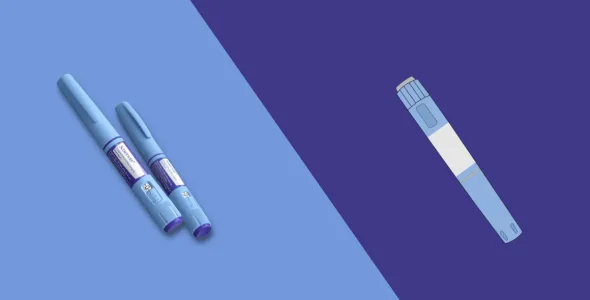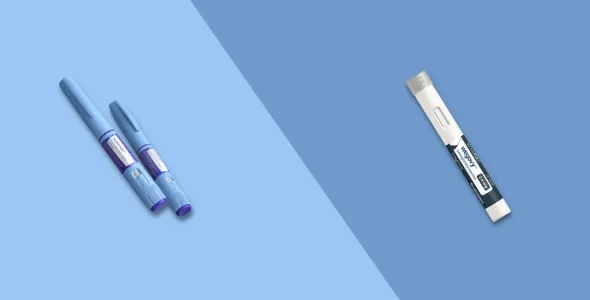Saxenda dosage chart for weight loss: The complete guide
Get clear Saxenda dosage instructions, including the crucial weekly increases and the target maintenance dose to maximize your weight loss safely and effectively.
Key highlights
- Get clear dosage instructions, including the crucial weekly increases and the target maintenance dose to maximize your weight loss safely and effectively.
- You start Saxenda with a dose of 0.6 mg once a day, injected under the skin. Your doctor will increase the dose by 0.6 mg each week until you reach the full dose of 3 mg daily, the maximum dose.
- If adolescents aged 12 to 17 can’t handle the full 3 mg dose of Saxenda, their doctor might lower it to 2.4 mg a day. This lower dose usually doesn’t work well for adults, so adults should typically stick to the full 3 mg daily.
Saxenda is an FDA-approved glucagon-like peptide-1 (GLP-1) receptor agonist used for chronic weight management in adults and adolescents with obesity or weight-related conditions.
Starting with a low dose of Saxenda and increasing it slowly helps your body get used to the medicine and can reduce side effects.
Not sure about Saxenda dosage? Learn the exact dosing schedule, how to titrate properly, when to increase, and tips to minimize side effects.
Understanding the Saxenda dosage: A step-by-step guide
Saxenda comes as a prefilled, multi-dose pen (3 ml) that contains 18 mg of medicine. When you start using it, one pen will last for 17 days. A full pack, which has five pens, will last for about six weeks.
You’ll use the same Saxenda pen for several doses, but make sure to use a new needle each time. You can inject the medicine under the skin of your stomach, thigh, or upper arm.
Each Saxenda pen can give you one of the five doses:
- 0.6 mg
- 1.2 mg
- 1.8 mg
- 2.4 mg
- 3 mg
Starting dose
The recommended initial dose of Saxenda for chronic weight management is 0.6 mg once daily for the first week to help your body adjust to the medication and minimize potential gastrointestinal side effects.
After this, your healthcare provider will slowly increase the weekly amount by 0.6 mg until you reach 3 mg daily. This 3 mg dose is called the maintenance dose, the amount you will keep taking as an ongoing dose.
Weekly titration
The specific weekly titration schedule is as follows:
- Week 1: 0.6 mg once daily
- Week 2: 1.2 mg once daily
- Week 3: 1.8 mg once daily
- Week 4: 2.4 mg once daily
- Week 5 and beyond (maintenance dose): 3.0 mg once daily
Following the recommended dose schedule can help reduce stomach side effects like nausea and diarrhea. If you can’t handle the 3 mg dose, your doctor might suggest a different weight-loss medication, since lower doses usually don’t work well for adults.
Maintenance dose
After you finish the 4-week dose increase and reach the full 3 mg daily dose, one Saxenda pen will last 6 days. A pack of five pens will last 30 days.
Maximum daily dose
The maximum recommended daily dose for adults is 3 mg.
Taking more than 3.0 mg per day is not recommended. It won’t lead to more weight loss and may increase the risk of side effects like nausea, vomiting, or low blood sugar. Always follow your healthcare provider’s instructions and never exceed the prescribed dose.
Here’s the week-by-week Saxenda dosing schedule (titration plan):
Saxenda dosage titration
| Week | Daily Dose |
|---|---|
| Week 1 | 0.6 mg |
| Week 2 | 1.2 mg |
| Week 3 | 1.8 mg |
| Week 4 | 2.4 mg |
| Week 5+ | 3 mg (Maintenance Dose) |
Never increase the dose faster than prescribed by your doctor. This gradual increase helps your body adjust and reduces the risk of side effects like nausea or stomach upset.
Saxenda dosage for adolescents (12-17 years old)
Saxenda is FDA-approved for use in adolescents (12-17 years old) who meet the following requirements:
- Those who weigh over 132 pounds and are considered obese based on adult body mass index (BMI)
- Obese, or overweight, with at least one weight-related condition such as high blood pressure, type 2 diabetes, or high cholesterol
Saxenda must be used in conjunction with a reduced-calorie diet and increased physical activity.
Adolescents aged 12 and older should usually take the same Saxenda doses as adults. Some kids might need more time to slowly increase their dose. For teens, it can take up to 8 weeks to reach the full 3 mg dose (maintenance dose).
The dose increase for your child is done the same way as for adults. If your child can’t handle the full dose, talk to their doctor. The doctor might lower the dose to 2.4 mg a day. If your child still has trouble with this lower dose, tell the doctor, who may suggest other weight-loss options.
What are the benefits of Saxenda?
Saxenda offers several potential benefits beyond just losing weight, making it a valuable option for people with obesity or overweight and related health concerns:
- Significant and sustained weight loss: Clinical trials show that patients using Saxenda can lose an average of 5% to 10% of their body weight when combined with a reduced-calorie diet and increased physical activity. Some patients achieve even greater results with consistent use.
- Improvement in weight-related health conditions: Saxenda has been shown to help improve blood pressure, lower LDL (bad) cholesterol, and stabilize blood sugar levels, especially in people with prediabetes or type 2 diabetes.
- Better appetite control: As a GLP-1 receptor agonist, Saxenda helps regulate appetite and reduce cravings, making it easier to stick to healthy eating habits.
- Improved quality of life: Many patients report better energy levels, increased mobility, improved mood, and higher confidence as a result of weight loss and better health.
- Approved for adolescents: Saxenda is also FDA-approved for weight management in adolescents 12–17 years of age with obesity, offering an important treatment option for younger individuals struggling with weight-related issues.
These benefits highlight Saxenda’s role not just as a weight-loss drug, but as part of a comprehensive approach to improving overall health and well-being.
How to inject Saxenda
Saxenda is a multi-dose pen, taken once daily and administered under the skin (subcutaneously). You can inject the medication under the skin of your stomach (at least 2 inches away from the belly button), upper arm, or thigh.
Pinch a fold of skin and insert the needle at a 90-degree angle for proper injection. Be sure to rotate injection sites each day to prevent skin irritation.
Before each use, check the label to make sure it says Saxenda. Always attach a new needle for each injection to avoid infection or injury.
Follow these steps to inject:
- Turn the dose selector on the pen to your prescribed amount (0.6 mg up to 3.0 mg).
- Pinch the skin, insert the needle into the pinched area, and press the injection button slowly and steadily.
- Hold the button down for several seconds after the dose is delivered to make sure all the medicine goes in.
- Remove the needle, safely dispose of it in a sharps container, and replace the pen cap.
Never share your Saxenda pen with anyone, even if the needle has been changed. Sharing pens can spread serious infections.
Store the Saxenda pre-filled pen in the refrigerator at a temperature between 36°F to 46°F (2°C to 8°C) before first use. Once you start using the pen, it can be kept at room temperature, up to 86°F (30°C), for a maximum of 30 days.
Be sure to protect the pen from light and heat during storage. Do not freeze Saxenda, and if it has been frozen, do not use it. Always keep the pen capped when it is not in use to maintain its effectiveness.
What to do if you miss a dose
If you forget to take your Saxenda dose, inject it as soon as you remember. But if it’s almost time for your next dose, skip the missed one and take your next daily dose. Do not take an extra dose to make up for a missed one.
If you miss a dose and it is within 12 hours of your usual injection time, take the missed dose as soon as you remember. Take your next dose at the usual time the following day.
If you miss a dose and more than 12 hours have passed since your usual injection time, skip the missed dose. Take your next dose at the usual time the following day.
If you haven’t taken Saxenda treatment for more than 3 days, talk to your doctor about how to start again. You might need to begin again with the usual starting dose of 0.6 mg per day.
How to adjust your Saxenda dosage
Never change your Saxenda dose without medical advice from your healthcare provider. The dosage increase follows a titration schedule, a gradual step-by-step plan designed to help your body adjust and reduce the risk of side effects.
If you experience significant side effects like strong nausea, vomiting, or diarrhea, your doctor may recommend delaying the next dose increase or even temporarily lowering your dose until you feel better.
It’s very important to communicate any side effects or concerns with your doctor. This helps them guide you safely through your treatment and make any needed adjustments based on how well your body is handling the medication.
When to adjust your dose
Any changes to your Saxenda dose should only be made under the guidance of your doctor. Never adjust the dose on your own.
You may need to stay at your current dose if you’re experiencing severe nausea, vomiting, or diarrhea, or if your weight loss has slowed down but the medication is still helping. These are normal reasons to pause dose increases temporarily.
In some cases, your doctor may recommend longer intervals between dose increases, for example, waiting two weeks instead of one before moving to the next level.
For people who are more sensitive to side effects, your doctor might decide to keep you at a lower dose than the maximum of 3.0 mg, such as 2.4 mg.
Important considerations regarding Saxenda dosage
Here are some important things to remember about Saxenda dosage:
- Use only as prescribed: It is a prescription medicine and should be taken exactly as directed by a healthcare professional.
- Not for type 2 diabetes alone: Saxenda is meant for weight management and is different from liraglutide (the active ingredient) used to treat type 2 diabetes (called Victoza), which uses lower doses. Don’t use Saxenda to treat diabetes unless your doctor specifically prescribes it for that purpose (off-label).
- Combination with other weight loss medications: Do not combine Saxenda with other GLP-1 receptor agonists or other weight loss medicines unless your doctor tells you to. Mixing GLP-1 drugs can cause health problems.
- Long-term use: Saxenda is designed for long-term use to help manage weight, so it should be used along with healthy lifestyle changes and as your doctor recommends.
- Travel: If you plan to travel, make sure you have enough Saxenda and know how to store it properly while you’re away.
- Switching injection times: If you want to change the time you usually inject Saxenda, talk to your doctor first to make sure it’s safe.
Common dosage mistakes to avoid
Here are some common Saxenda dosage mistakes to avoid:
- Skipping titration steps can lead to severe gastrointestinal issues like nausea, vomiting, or diarrhea. It’s important to follow the gradual dose increase schedule to help your body adjust.
- Injecting right after eating may also worsen nausea, so it’s better to wait a little while before or after meals.
- Using expired pens can lose effectiveness and may not provide the intended results.
- Do not mix Saxenda with other GLP-1 medications (like Wegovy or Ozempic), as this can increase the risk of overdose and serious side effects. Always follow your healthcare provider’s instructions closely.
If you take too much Saxenda, you might have stronger side effects like bad nausea, vomiting, or low blood sugar. Some people have had symptoms like pancreatitis (swelling of the pancreas) after taking too much. In serious cases, an overdose may require hospital treatment.
Can you switch from Saxenda to Wegovy?
Yes. With your doctor’s help, you can switch from Saxenda to Wegovy (semaglutide). Wegovy is a once-a-week injection that is also approved for long-term weight loss in people 12 and older. Some people find Wegovy weekly injections easier to use than Saxenda, and it may help you lose more weight.
There isn’t a matching dose between Saxenda and Wegovy. You’ll probably start with the lowest Wegovy dose and follow its usual titration schedule. Your doctor can help you switch safely if you want to try Wegovy.
Side effects
The most common side effects of Saxenda are usually mild and tend to improve over time:
- Nausea
- Vomiting
- Diarrhea
- Constipation
- Headache
- Stomach pain
- Dizziness
- Fatigue
- Hoarseness
- Hypoglycemia or low blood sugar (especially when used with diabetes medications)
- Decreased appetite
- Trouble swallowing
Rare and serious side effects of Saxenda that may require immediate medical attention include:
- Pancreatitis (inflammation of the pancreas)
- Gallbladder problems (gallstones)
- Kidney problems (including kidney failure)
- Increased heart rate or fast heartbeat
- Injection site reactions
- Suicidal thoughts
- Serious allergic reactions
Nausea is the most common side effect when starting Saxenda, but it usually gets better as your body gets used to the medicine. You might feel more side effects when you increase the dose, but these usually settle down in a few days.
If you feel sick, here are some simple tips that might help:
- Eat plain, low-fat foods like toast, crackers, or rice
- Try foods with lots of water, like soup or jelly
- Limit spicy foods and alcohol
- Don’t lie down right after eating
- Get some fresh air outside
- Wear loose clothing
It’s essential to remember that any changes to your weight loss medication, whether starting, stopping, or switching, depend on your medical condition and should only be made under the medical advice of a qualified healthcare provider. Always tell your doctor or pharmacist about all over-the-counter medications, supplements, and vitamins you take.
Special populations: Dosage adjustments
Elderly (65+)
- For older adults aged 65 and over, doctors usually recommend increasing the Saxenda dose more slowly than for younger people. This slower dose titration (increase) helps their bodies adjust better to the medicine and reduces side effects.
- Also, older adults have a higher risk of hypoglycemia, which means their blood sugar can drop too low. Because of this, doctors will monitor them closely and may adjust treatment to keep their blood sugar safe while using Saxenda.
Renal impairment
- People with kidney or liver problems usually take the normal Saxenda doses. In some cases, Saxenda can affect how well the kidneys work. If you have had kidney problems before, your doctor may check your kidney function regularly to make sure everything is okay.
- Tell your doctor if you have nausea, vomiting, or diarrhea that doesn’t stop. These side effects can happen with Saxenda, but they can also cause dehydration, which might increase the chance of kidney problems.
- If you have mild or moderate kidney problems, you usually don’t need to change your Saxenda dose. But if your kidney function is very poor (GFR below 30), you should avoid using Saxenda.
How to save on Saxenda?
Here are some strategies that can be used to save on Saxenda:
Check insurance coverage
Look up your health plan’s formulary to see if Saxenda is covered. Ask your insurance provider if there are any prior authorization or step therapy requirements that may apply. Have your provider’s office help with the insurance approval process if needed.
Saxenda Savings Card program
Novo Nordisk, the manufacturer of Saxenda, offers a Saxenda savings card program, which is available for commercially insured patients who may pay as little as $25 per 30-day prescription.
This card can be used at participating pharmacies. It is not valid for patients on Medicare, Medicaid, or other federal/state healthcare programs.
Pharmacy discount cards
Free discount programs like GoodRx, SingleCare, and WellRx may help lower out-of-pocket costs if you’re paying cash.
Prices can vary, so try comparing prices at all prescription drug discount websites and local pharmacies.
Generic liraglutide
The FDA approved generic liraglutide (Victoza), the first generic of a once-daily GLP-1 injection, in December 2024.
As of May 2025, no generic Saxenda (liraglutide for weight loss) is available in the U.S. However, a generic version of Victoza, the type 2 diabetes version of liraglutide, has been approved.
Compounded liraglutide
Compounded liraglutide is made by compounding pharmacies, which mix medications tailored to individual needs, often when the original drug is unavailable or too expensive. Unlike FDA-approved medications like Saxenda or Victoza, compounded drugs are not reviewed for safety, effectiveness, or quality by the FDA. This means there could be risks, such as incorrect strength, contamination, or improper storage.
If you’re considering compounded liraglutide, it’s important to speak with a healthcare provider. They can help you weigh the risks and benefits and ensure you’re using a product from a reputable source if it’s appropriate for you.
Discuss alternatives with your doctor
Ask your healthcare provider if other GLP-1 meds (Wegovy, Ozempic, or even generic liraglutide) might be an option, knowing they may have different indications, dosing, and effects.
Other weight loss medications like Contrave, Qsymia, or Phentermine may be cheaper and have generic versions.
Who should not take Saxenda? Contraindications and warnings
Saxenda comes with a box warning about the possible risk of thyroid tumors. People with a personal or family history of medullary thyroid cancer (MTC) or multiple endocrine neoplasia type 2 (MEN 2) should avoid this medication.
Saxenda can increase heart rate, which may cause problems for people with heart disease or high blood pressure. It also carries risks like pancreatitis, gallbladder disease, kidney problems, and suicidal thoughts or behaviors. Low blood sugar (hypoglycemia) is another risk, especially for people taking other diabetes medications.
Get medical help right away if your side effects last or get worse. You should seek emergency care if you have signs of an allergic reaction, like hives, swelling in your face or throat, or trouble breathing.
Boxed warning
Saxenda (liraglutide) carries an FDA-boxed warning due to the risk of thyroid C-cell tumors or thyroid cancer observed in animal studies.
In rodent studies, GLP-1 receptor agonists like Saxenda and Wegovy caused thyroid C-cell tumors, including medullary thyroid carcinoma (MTC).
It’s not known whether these findings apply to humans, but the potential risk cannot be ruled out.
Do NOT use Saxenda if:
- You have a personal or family history of MTC, a rare type of thyroid cancer
- You have been diagnosed with Multiple Endocrine Neoplasia syndrome type 2 (MEN 2), a genetic condition linked to endocrine tumors.
- Serious allergic reaction to liraglutide or any of the ingredients in Saxenda.
- Are pregnant or planning to become pregnant
- Are breastfeeding, as it is not known if Saxenda passes into breast milk
- Have serious kidney or liver problems
Conclusion
When starting Saxenda (liraglutide) for weight loss, the first dose is 0.6 mg injected under the skin once a day for the first week.
The dose is slowly increased every week in 0.6 mg increments over 5 weeks until you reach the full dose of 3 mg once a day, which is also the maximum dose. Some people may need more time to adjust and might follow a slower increase schedule.
Adolescents who can’t handle the full 3 mg dose of Saxenda might be able to take 2.4 mg a day instead. Adults taking less than 3 mg a day is not recommended because lower doses usually don’t work well for them.
It is important to follow the prescribed Saxenda dose and titration schedule to ensure it works safely and effectively.
Stay in regular contact with your healthcare provider to discuss your Saxenda dose, any side effects, and your progress, ask questions, and take an active role in your weight loss journey.





